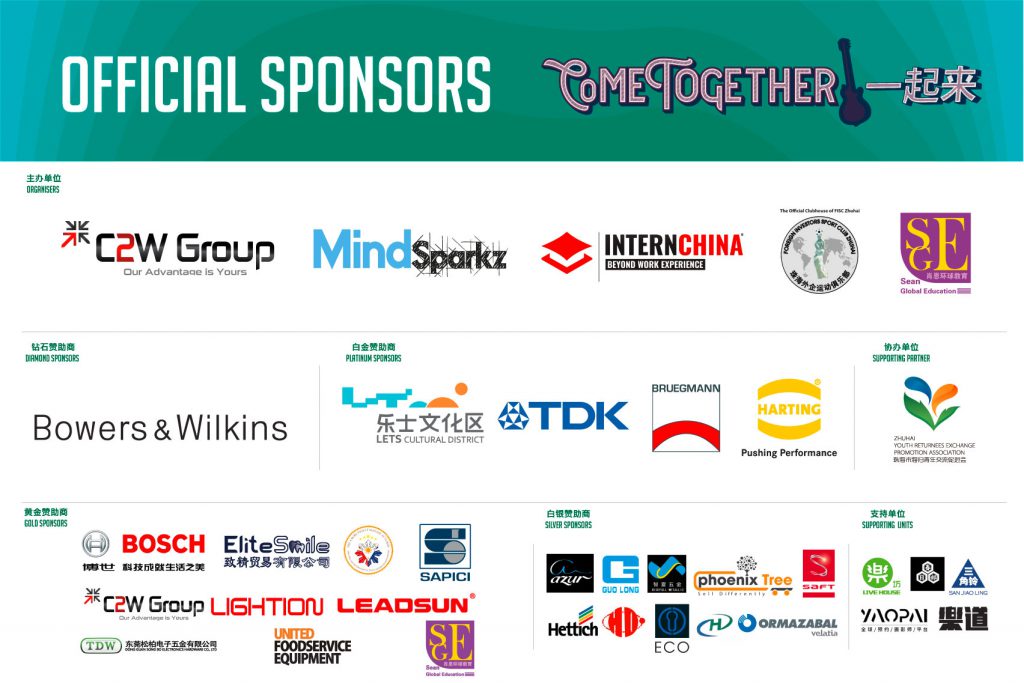
World Autism Awareness Day
世界自闭症日
In support of World Autism Awareness Day, April 2nd, 2019 our CTC logo is changing blue for the entire World Autism Month of April. Join us in increasing global understanding and acceptance of people with autism.
为了支持2019年4月2日的世界自闭症日,我们的CTC的标志将为整个4月份的世界自闭症月更换为蓝色。请加入我们,增进全球对自闭症患者的理解和接受。
Special Needs in China
中国的特殊需求群体
CTC is pleased to support children in financial need, children from single or no parent families, children with autism and children with other various disabilities.
CTC很高兴能支持有经济需要的儿童、单亲家庭儿童或孤儿、自闭症儿童、及其他残疾儿童。
CTC initially started with a focus on fund-raising for children in Zhuhai that needed financial assistance in areas such as education. However, CTC also observed how families with special needs children were also struggling, especially those who had low incomes and limited social support. CTC principally aims to support the child’s need but also recognises the importance and impact that special needs and financial strain can have on the whole family.
CTC最开始专注于为珠海需要经济援助的儿童集资,例如教育方面的经济援助。然而,CTC也注意到了有特殊需要儿童的家庭也在苦苦挣扎,特别是那些低收入和社会援助有限的家庭。CTC的主要目的是支持儿童的特殊需要,同时也认识到特殊需要及财务压力对整个家庭的重要性和影响。
An Introduction to Autism
自闭症介绍
CTC funds many programs that support children with autism in their physical, cognitive and socioemotional development. Autism is a broad term that encompasses a large spectrum of conditions where symptoms are recognizable in various degrees. Broadly known as Autism Spectrum Disorder (ASD), there are a range of conditions that have similar characteristics. Those living with autism usually have problems using both verbal and non-verbal behaviours to interact with others. They often have difficulty expressing themselves and interpreting eye contact, facial expressions, body language and hand gestures. Those with autism may also have attention deficit hyperactivity disorder (ADHD), anxiety, depression, or other physical medical conditions. Often those with autism can appear like they are living in their own world and quite oblivious to what is happening around them (unless they are in a stressful situation).
CTC资助了许多开发自闭症儿童的身体、认知和社会性情绪的项目。孤独症是一个广义的术语,它包含了各种不同程度的症状。广义的自闭症谱系障碍(ASD)有一系列相似的特征。那些患有自闭症的人通常在使用语言和非言语行为与他人互动方面存在问题。他们往往难以表达自己、难以理解眼神交流、面部表情、肢体语言和手势。自闭症患者也可能患有注意缺陷多动障碍(ADHD)、焦虑、抑郁或有其他身体健康状况。通常自闭症患者会像生活在自己的世界里一样,对周围发生的事情毫不在意(除非他们处于压力状态下)。
ASD broadly is often characterised by repetitive behaviour and strict adherence to routine. Children and young people with ASD frequently experience a range of cognitive (thinking), learning, emotional and behavioural problems. Although these children (and adults) lack some of the common personality traits needed to take part in today’s society, their condition can also positively allow them to have immense talents and strengths in other aspects of life, such as creativity and art.
一般来说,ASD的特点是重复性的行为和严格的遵循固有习惯。患有ASD的儿童和年轻人经常会有一系列的认知(思考)、学习、情感和行为问题。虽然这些孩子(和成人)缺乏参与当今社会所需要的一些共同的个性特征,但他们的条件也能很好地让他们在生活的其他方面拥有巨大的天赋和优势,比如创造力和艺术方面。
Because children on the autism spectrum struggle to make strong inter-personal bonds or form relationships with other people, they end up suffering from severe loneliness. They desire the connections and emotions that result from meaningful relationships, but lack the social or cognitive skills to form them. Children with autism desire friendships in exactly the same way that children without autism do. CTC supports programs that encourage children with autism in developing their social skills and understanding social situations. These are some key skills that will benefit their ability to form and maintain relationships in their life.
因为自闭症谱系障碍的孩子很难与他人建立亲密的人际关系或形成联系,他们最终会承受严重的孤独感。他们渴望有意义的人际关系所产生的联系和情感,但缺乏形成这些关系的社交或认知技能。自闭症儿童对友谊的渴望和没有自闭症的孩子是一样的。CTC所资助的项目支持自闭症儿童发展其社交技能和了解社会状况的能力。这些都是一些关键的技能,这些技能有利于他们在生活中形成和维持人际关系。
Awareness of autism in China has grown in recent years, fuelled by parents and autism awareness organizations. Autism was officially recognised as a disability in China in 2006 and since then, awareness has been rising. At CTC we are proud to be funding projects for children with autism in Zhuhai. The past decade has recognized autism as a condition in need of greater attention, and CTC recognises that the whole family is affected when a child is diagnosed with autism. With the help of local charities combined with the funds raised by those who sponsor and attend each Come Together event, we increase the awareness of autism and help these children to foster and nourish their natural abilities.
近年来,在自闭症儿童父母和认知组织的推动下,中国的自闭症认知有所增强。2006年,中国正式将自闭症认定为残疾,自那以后,人们对自闭症的认知一直在增强。CTC为能资助珠海的自闭症儿童项目感到自豪。过去的十年时间证实了自闭症是一种需要更多关注的疾病状况,而CTC发现当孩子被诊断患有自闭症时,整个家庭都会受到影响。在当地慈善机构的帮助下,加上企业赞助和CTC活动参与者筹集的资金,我们提高了大众对自闭症的认知,帮助这些孩子培养和发展他们的天赋。
History/Present Circumstances of Special Needs in China
中国特殊需求人群的历史/现状
In 1951, the Decision to Reform the Education System (organised by the Chinese Political Council) required all governments in China to establish schools for individuals with visual, hearing and physical disabilities. This document, for the first time in Chinese educational history meant that children and adolescents with disabilities experienced some degree of educational inclusion. More recently, over the past two decades, legislative and administrative progress has been made with serious steps to improve the living conditions and social status of those living with disabilities.
1951年,中国教育体制改革(由中国政治委员会组织)要求各级政府为视觉、听觉和身体残疾人士成立专门的残疾人学校。在中国教育史上,该文件首次表明残疾儿童和青少年受到一定程度的教育包容。最近在过去的20年里,中国在立法和行政方面已经取得了进步,采取了重要的步骤来改善残疾人的生活条件和社会地位。
The Law on the Protection of Disabled Persons (1991/2008) addresses a variety of issues including education for those with disabilities. This means that the educational future of those living with learning difficulties is beginning to look more positive.
《残疾人保障法》(1991/2008)解决了各种问题,包括残疾人的教育问题。这意味着有学习障碍的人教育前景将更乐观。
In the 1980s there was a drive towards inclusion in education in China, with Learning in Regular Classrooms (LRC) being established. This meant that due to the compulsory education mandate, many children with special needs (who previously wouldn’t have been enrolled) were finally included in the education system.
20世纪80年代,随着在课堂学习的创立,在中国开始了全纳性教育的趋势。这意味着,由于义务教育的强制要求,许多有特殊需要的儿童(以前不被录取的)被纳入到教育系统中。
China’s previous labour market situation meant that learning disabilities often went unnoticed due to a traditionally higher emphasis on manual labour than education. This has led to a systemic tendency to a) not recognize learning disabilities, or b) not categorise certain disorders (such as ADHD) to need special services or assistance in everyday life. As a result, disabled Chinese are often denied access to specialist educational opportunities. They are either placed in mainstream education, which is not tailored to their specific needs, or denied access to education altogether. This means that only 25% of disabled children enrol in high schools or higher educational institutions, and in turn, this can lead to elevated poverty and poor living conditions for the disabled/special needs demographic.
中国以前的劳动力市场状况意味着,由于传统上强调体力劳动而不是教育,学习障碍常常被忽视。这导致了一种系统性倾向:a)认识不到学习障碍,或者b)不把某些日常生活中的疾病(如多动症)归类为需要特殊的服务或帮助。因此,中国的残疾人士通常无法获得特殊教育的机会。他们要么被放在无法满足其特定需求的主流教育中,要么干脆无法接受教育。这意味着只有25%的残疾儿童进入高中或更高的教育机构。反过来,这可能导致残疾人/特殊需要人口的进一步贫困和恶劣的生活条件。
In China, there are six classes of disability acknowledged. These are visual, hearing, intellectual, physical and psychiatric and multiple impairments. Although education became compulsory, it still doesn’t mean that children in main stream educational facilities are being provided with adequate support to make the most out of the available educational opportunities. Many educational establishments lack one or more of the necessary aspects that would enable a disabled child to have to same level of opportunity as that of a non-disabled student (such as funding, infrastructure, resources, support groups or teacher training). Regardless of the increase in enrolment for children with special needs, those with disabilities often slip under the radar and do not get adequate help in regular classrooms.
中国现在承认有六种等级的残障,即视觉、听觉、智力、身体、精神、及多重缺陷。虽然教育是强制性的,但是过去没有,现在也不意味着主流教育系统里的孩子有得到足够的支持,并充分利用现有的教育机会。许多教育机构或多或少都缺乏必要的条件,让残疾儿童能够获得与非残疾学生相同的机会水平(如资金、基础设施、资源、支助小组或教师培训)。尽管有特殊需要的儿童入学人数有所增加,但那些有缺陷的儿童经常被忽视,在常规的教室里得不到足够的帮助。
China has some of the highest population numbers for people living with disabilities worldwide and many of them are illiterate. A high percentage of those living with a disability also live in a rural setting where accessibility to help is little to none. Poverty and lack of education remain key obstacles in the personal growth and development of this demographic, and it has been estimated that over a quarter of children with disabilities receive no basic education.
中国有世界上人口最多的残疾人,其中很多人是文盲。残疾人中很高比例的一部分人也生活在农村地区,那里几乎没有人能提供帮助。贫困和缺乏教育仍然是这一人口个人成长和发展的主要障碍,据估计,超过四分之一的残疾儿童没有接受基础教育。
Because many children with special needs come from impoverished areas or low-income families, accessibility to resources and transport have historically presented (and still present) challenges to attendance. This is one area that CTC supports through our partner CPAZ (The Charity Promotion Association of Zhuhai), who supply children in Zhuhai with necessities for school that they wouldn’t be able to afford otherwise.
由于许多有特殊需要的儿童来自贫困地区或低收入家庭,资源的可获取性和交通情况对出勤是极大的挑战(过去是,现在仍是)。这是CTC支持的一个领域——珠海慈善促进会(CPAZ),为珠海的孩子提供他们无法负担的学校必需品。
In 1990 there was another legislative effort towards better inclusive education with The Protection of Disabled Person’s Law. This was towards having better quality pre-school programs and services available to children with disabilities. With a family focus, it promoted the idea that work units and communities have shared responsibility for the care of disabled individuals.
在1990年,除了《残疾人保障法》,还开展了另一项立法工作以实现更好的包容性教育。这是为了向残疾儿童提供更好的学前教育项目和服务。以家庭为中心,它推广了工作单位和社区需共同承担照顾残疾人的责任这一观念。
One key word to describe opportunity and accessibility of help for those disabled, or those with a disabled child, would be limited. Although reform has occurred, and the opportunities to take part in education apply, it is still difficult and plagued with limitations for those individuals who have disabilities, as well as their families. It remains an issue that although these children are being enrolled and admitted into inclusive educational systems and facilities, they are continuing to be segregated and disadvantaged. It takes more than simply enrolment for these children to succeed within an educational establishment. Individualised learning programmes and support is key.
用一个关键词来描述残疾人及残疾儿童家庭得到帮助的机会和可能性,那将是“有限”。尽管已经发生了改革,并且有机会参加教育,但是对于那些有残疾的人和他们的家庭来说,这仍然是困难和限制重重地。尽管被招收进有包容性的教育系统和机构,这些孩子仍将处于隔离的不利地位。想要让他们成功融入教育系统,仅仅是招收他们入学是远远不够的。关键是制定个性化的学习计划并给予相应支持。
Because communities are forming who raise awareness for special needs in China, the needs of those who live with a disability are becoming more and more acknowledged. Through education and awareness, the ability of organisations like ZAS, LJL and CTC aim to help and make a difference in these children’s lives. With the support of the community and organisations like the ones listed above, CTC can keep striving to provide the necessary aspects these children need to succeed and excel in their lives.
由于中国众多社会团体的成立并努力提高大众对特殊需求的认知,残疾人的需求也越来越得到认可。通过教育和认知的提高,像ZAS、LJL和CTC这样的组织旨在帮助和改变这些儿童的生活。在这些团队和机构的支持下,CTC可以继续努力提供必要的资助,让这些孩子在他们的生活中取得成功和出人头地。
References and Bibliography
Autism Speaks. (n.d.). What Is Autism? Retrieved from: https://www.autismspeaks.org/what-autism
Bi, YingHu., Training Needs for Implementing Early Childhood Inclusion in China, (2010) International Journal of Early Childhood Special Education (INT-JECSE), June 2010 2:1
Deng, M. & Holdsworth, J. C. (2007). From unconscious to conscious inclusion: meeting special education needs in West China. (Journal for Disability & Society; 507-522; 22(5)). Retrieved from: http://www.tandfonline.com.ezproxy.lincoln.ac.nz/doi/full/10.1080/09687590701427644?scroll=top&needAccess=true#
Human Rights Watch. (2017). China: New Rules for Students with Disabilities Inadequate. Retrieved from: https://www.hrw.org/news/2017/03/06/china-new-rules-students-disabilities-inadequate
Kritzer, Jeffery B., Comparing Special Education in the United States and China, (2012), International Journal of Special Education, Vol 27, Nov 2, 2012
Krizter, Jeffery B., Special Education in China (2011), Eastern Educational Journal, Volume 40(1) Spring 2011, pp 57-63
Niederhofer (nee Jenson), K. (2016). – Private Resource available on file for CTC (Information Resources>Special_Needs_Report(3))
Ryan, J., Chen, L. C. & Saich, T. (2014) Philanthropy for Health in China. Indiana University Press. Retrieved from: https://ebookcentral.proquest.com/lib/lincoln-ebooks/detail.action?docID=1782268#






